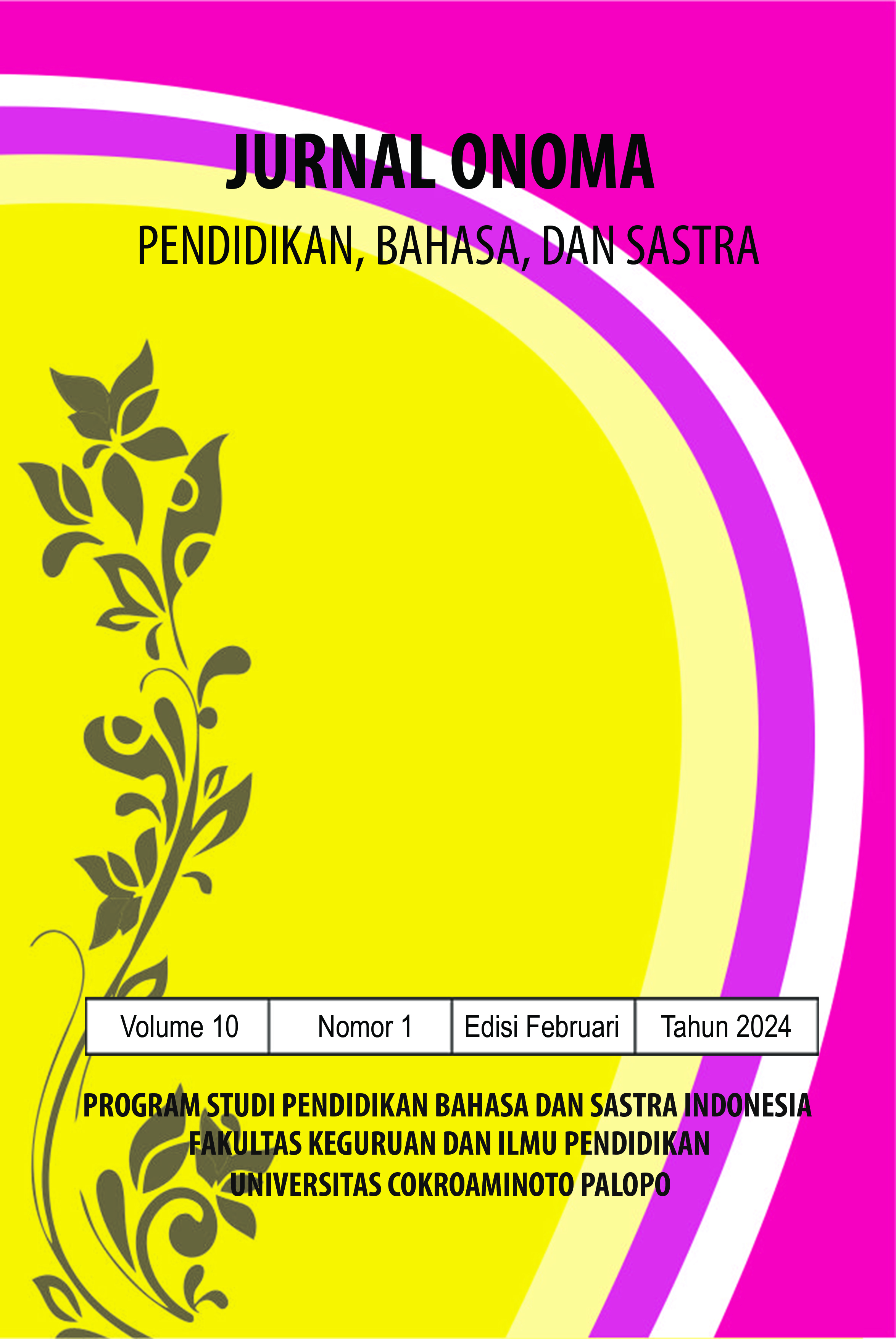Analisis Tingkat Bilingualisme Penutur Bahasa Makassar di Ambon
https://doi.org/10.30605/onoma.v10i1.3449
Keywords:
bilingualisme penutur Makassar, sosiolinguistikAbstract
Artikel ini bertujuan untuk membahas tingkat penguasaan bilingualisme penutur bahasa Makassar yang tinggal di Ambon. Pendekatan penelitian ini menggunakan pendekatan sosiolinguistik. Sumber data penelitian ialah penutur bahasa Makassar yang tinggal di Ambon. Jenis data penelitian ini adalah tuturan verbal dan teks hasil uji kompetensi penutur. Pengumpulan data yang dilakukan mencakup studi dokumentasi dan wawancara mendalam. Tahap penelitian ini ada tiga tahap yaitu, tahap (1) reduksi, (2) penyajian, dan (3) penarikan kesimpulan. Kesimpulan hasil penelitian ini ditemukan bahwa tingkat bilingualisme penutur bahasa Makassar di Ambon ialah bilingualisme koordinatif. Sebagai penutur bilingualisme koordinatif, penutur mampu menggunakan dua bahasa yang sama baiknya secara lisan maupun secara tertulis yaitu, bahasa Makassar dan bahasa melayu Ambon. Adapun faktor yang mempengaruhi penguasaan bilingualisme penutur yakni, faktor internal dan faktor eksternal. Faktor internal ialah faktor yang ada dalam diri penutur dan pengalaman pemerolehan bahasa penutur. Faktor eksternal ialah faktor lingkungan sosial, keluarga, dan penggunaan alat komunikasi handphone.
Downloads
References
Agustia, K. T. S. (2017). Interferensi Bahasa Indonesia terhadap Pemakaian Bahasa Inggris Pada Siswa Kelas VIII Sekolah Menengah Pertama. Litera Jurnal Bahasa dan Sastra, 3(1), 98–108.
Aritonang, B. (2017). Bahasa Indonesia, Daerah, dan Asing Di Wilayah Perbatasan: Studi Pada Bahasa Walsa dan Muyu. Jurnal Pendidikan Dan Kebudayaan, 2(2),180.Https://Doi.Org/10.24832/Jpnk.V2i2.661
Bialystok, E., & Shorbagi, S. H. (2021). Subtle Increments In Socioeconomic StatusAnd Bilingualism Jointly Affect Children’s Verbal And Nonverbal Performance. Journal Of Cognition And Development, 22(3), 467–490. https://doi.org/10.1080/15248372.2021.1901711
Block, D. (2007). Bilingualism: Four Assumptions and Four Responses. Innovation InLanguageLearning And Teaching, 1(1), 66–82. https://doi.org/10.2167/Illt043. 0
Erniati. (2018). Pemertahanan Bahasa Bugis Di Kota Ambon. Toto Buang, 6(2).
Intan, T., & Handayani, V. T. (2020). Fenomena Campur Kode dalam Novel Metropop Antologi Rasa Karya IkA NATASSA (Mixed-codes Phenomenon in the Metropop Novel of Antologi Rasa by IkNatassa). Kandai, 16(2), 259. https://doi.org/10.26499/jk.v1 6i 2.1285
Kaltsa, M., Prentza, A., Papadopoulou, D., & Tsimpli, I. M. (2020). Language External and Language Internal Factors In The Acquisition Of Gender: The Case Of Albanian-Greek And English-Greek Bilingual Children. International Journal of Bilingual Education and Bilingualism, 23(8), 981–1002. https://doi.org/10.1080/13670 05 0.2017.1385591
Miles, M. B. & A. Huberman, Michael. (2014). Analisis Data Kualitatif: Buku Sumber Tentang Metode-Metode Baru. Universitas Indonesia.
Muharam, R. (2011). Alih Kode, Campur Kode, Dan Interferensi yang Terjadi dalam Pembicaraan Bahasa Indonesia dan Bahasa Melayu Ternate. 1, 11.
Mutmainnah, Y. (2008). Program Pascasarjana Universitas Diponegoro Semarang. 162.
Paramita, N. P. (2017). Implementasi Pendekatan Sosiolinguistik dalam Pembelajaran Bahasa Arab. Al-Manar, 6(2). https://Doi.Org/10.36668/Jal.V6i2.75
Park-Johnson, S. K. (2020). Teachers’ Attitudes and Beliefs About Code-Mixing by Bilingual Students. Educational Studies, 56(2), 125–144. https://doi.org/10.1080/0013194 6.2019.1694026
Pranowo. (2014). Teori Belajar Bahasa. Pustaka Belajar.
Putri, S. N. (2018). Analisis Alih Kode pada Bahasa Guru dalam KegiatanPembelajaran di Kelas Bilingual. Kandai, 14(1), 119. https://doi.org/10.26499/jk.v1 4i 1.635
Saunir, S. (2008). Profil Kedwibahasaan Mahasiswa Bahasa dan Sastra Inggris. Lingua Didaktika: Jurnal Bahasa dan Pembelajaran Bahasa, 2(1), 29. https://doi.org/10.24036/ld.v2i 1.7358
Spradley, J. P. (2007). Metode Etnografi. Tiara Wacana.
Sugiyono. (2013). Metode Penelitian Pendidikan: Pendekatan Kuantitatif, Kualitatif, dan R&D. Alfabeta.
Turnbull, B. (2018). Reframing Foreign Language Learning As Bilingual Education: Epistemological Changes Towards The Emergent Bilingual. International Journal of Bilingual Education and Bilingualism, 21(8), 1041– 1048. https://doi.org/10.1080/1367005 0.2016.1238866
Vender, M., Hu, S., Mantione, F., Savazzi, S., Delfitto, D., & Melloni, C. (2021). Inflectional morphology: Evidence for an advantage of bilingualism in dyslexia. International Journal of Bilingual Education and Bilingualism, 24(2), 155–172. https://doi.org/10.1080/13670 05 0.2018.1450355
Zenab, A. S. (2016). Kedwibahasaan Anak Sekolah Dasar dan Implikasinya terhadap Pembelajaran Bahasa Indonesia. 2, 9.
Downloads
Published
How to Cite
License
In submitting the manuscript to the journal, the authors certify that:
- They are authorized by their co-authors to enter into these arrangements.
- The work described has not been formally published before, except in the form of an abstract or as part of a published lecture, review, thesis, or overlay journal.
- That it is not under consideration for publication elsewhere,
- That its publication has been approved by all the author(s) and by the responsible authorities – tacitly or explicitly – of the institutes where the work has been carried out.
- They secure the right to reproduce any material that has already been published or copyrighted elsewhere.
- They agree to the following license and copyright agreement.
License and Copyright Agreement
Authors who publish with Onoma Journal: Education, Languages??, and Literature agree to the following terms:
- Authors retain copyright and grant the journal right of first publication with the work simultaneously licensed under Creative Commons Attribution License (CC BY 4.0) that allows others to share the work with an acknowledgment of the work's authorship and initial publication in this journal.
- Authors are able to enter into separate, additional contractual arrangements for the non-exclusive distribution of the journal's published version of the work (e.g., post it to an institutional repository or publish it in a book), with an acknowledgment of its initial publication in this journal.
- Authors are permitted and encouraged to post their work online (e.g., in institutional repositories or on their website) prior to and during the submission process, as it can lead to productive exchanges, as well as earlier and greater citation of published work.

















